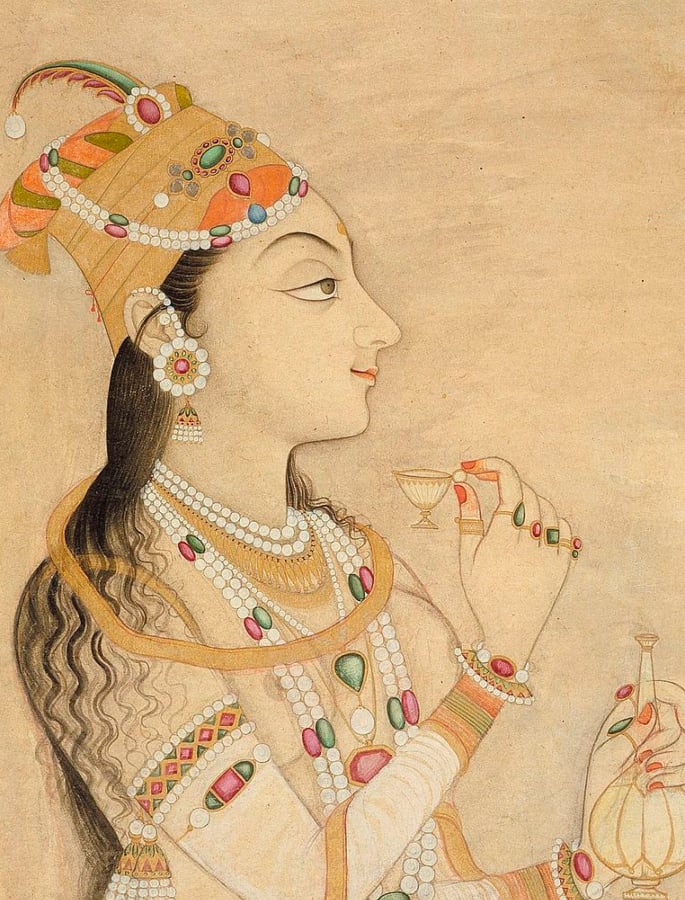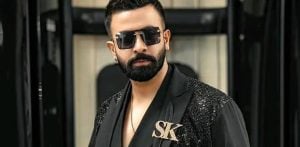The tradition was practised to conceal female beauty
Fashion in India is as colourful as the nation itself. It reflects the country’s rich cultural heritage and aesthetics of thousands of years.
The Indian vogue scene covers an array of styles, blending the best of traditional techniques and modern ideologies to create a fusion of the East and the West.
From sarees being draped in distinct ways to skinny jeans donned by men to unconventional hues like black adopted for special occasions, fashion in India has travelled a long way.
But, where did it all begin?
An interesting aspect of fashion is that it is reinvented again and again to mirror the values and circumstances of any given period. It is never a new phenomenon.
The Indian fashion scene is no different. It has undergone milieu of transformations to exhibit the social, cultural and economic state while retaining its flamboyant nature.
The history of fashion in India is no less prolific and can be charted back to the ancient ages known to the human mind.
Starting from the very beginning; the ancient civilisations let us understand how fashion has evolved through the decades.
The Era of Minimalistic Fashion – Indus Valley Civilisation

The history of fashion in India can be traced back to the Indus Valley Civilisation.
Figurines and seals excavated from this world existing around 3300 to 1300 BC. They show us that minimalism or even nudity defined the mode of fashion at that time.
A plain, unstitched piece of cloth was all that the people of Harappa and Mohenjodaro put on their body.
The limited depictions found show men wearing a cloth around their waist. It is passed between the legs and tucked behind at the back, resembling the modern dhoti.
Turbans were also a part of their daily wear to protect themselves from the heat.
Some men also draped a shawl over their left shoulder, as is deciphered from a statue of a man discovered at the site of Mohenjodaro.
Because of the meditative expression on its face, the statue is presumed to be that of a priest. Thus, it can also be assumed that men with privilege often covered their upper body.
The earliest representations of women’s fashion show them in a knee-length skirt with the upper body left bare.
The famous dancing girl figure, also discovered at sites of Mohenjodaro, is wearing no clothes. However, her neck and arms are heavily ornamented.
Minimal clothing is often linked with primitive cultures. However, this is not the case with the Indus Valley Civilisation for the trend is common throughout the populace.
In fact, one can say that the role of clothing was nowhere confined to the ideals of modesty. Instead, it was to adorn and accentuate attractive attributes.
Jewels and accessories, including necklaces, earrings, bangles, anklets, armlets and belts were worn by both men and women. Elaborate headdresses were quite a fad, adding to overall sensuality.
Unstitched garments wrapped or draped in ways teamed with jewellery and fancy headgears were the society’s style statement.
From the tiny fragments of clothing found, it can be said that woven cotton fabrics and silk were used in this Bronze Age. Dyeing of cotton also began here.
While there’s no mention of wools, Harappa’s trade with Mesopotamia may have brought in supplies of Mesopotamian wool. Cold weather may have also called for the use of animal skins.
The Age of Apsaras – Vedic Period

Little had changed in terms of fashion as the Vedic age set in. Due to the hot weather, single pieces of unstitched cloth remained a preference.
Antariya, similar to a loincloth, was meant for the lower part of the body. A versatile piece of garment, it could be draped in various ways.
One could simply wrap it around the waist with pleats in the front. It could also be taken between the legs and tucked behind in Kaccha style. Working women found the latter style convenient.
The sculptures and paintings found revealed that the Antariya varied in length. It ranged from the size of the modern-day mini-skirts to ankle length.
The fabric ranged from translucent to thick depending on the person.
Another article called Uttariya was also worn in several ways, which leaned on individual comfort and whims of the weather.
Some wore it diagonally across the chest. Others put it on loosely across the back, resting on shoulders and supported by the wrist, similar to the way a modern dupatta is held.
Both the sexes chose to keep the upper part of the body uncovered.
A Kayabandh, which is like a belt, was tied fashionably to hold the Antariya in place. Usually, it was fastened below the navel to emphasise the curves.
Unisex fashion ruled the early period of the era when knowledge transpired in the form of the Vedas; the oldest Indian texts.
Although sewn and stitched garments were still not in use, people had learnt the art of embellishment.
The costumes, therefore, were rectangular pieces of cloth coloured and embellished with gold and silver threads.
Stitched & Sewn To Trade & Textiles – The Age of Dynasties

The late and post-Vedic age saw gradual changes occur in the dressing sense of people. As kingdoms were built and trade was established, this portion of the history of fashion in India saw Greco-Roman influences.
The first largest empire found by Chandragupta Maurya and the Sunga dynasty carried forward the trend of the early Vedic period. The only difference was that some married women wore a breast band.
The Greeks got tunics, while the Romans brought to India various ways of draping. Some believe that the saree came into existence in this age, although the matter is still under debate.
Ancient Roman female costumes involve a long tunic, over which a rectangular piece of wool is pulled over the head, bearing resemblance to the Indian saree.
Fascinatingly, this rectangular cloak-like garment was called the Palla; the decorated part of the saree. This led many historians to believe that the classic saree is the result of Roman influence.
However, from what the major part of the history of fashion in India tells us, is that the saree came to be after the switch to stitched and sewn clothes.
The Kushan rulers can be accredited to bring about a revolution in the Indian fashion scene. We see a shift from purely draped garments to cut and sewn ones in their time.
Long tunics, coats, and trousers came into being, while the Antariya and Uttariya remained in vogue, worn by the most indigenous folks.
Stitched garments were not only the new favourite but also gained status. They were associated with royalty as we progress into the Gupta period.
The tunic or Kancuka worn by the population was reinvented into brocaded attire with sleeves for the courtiers and ministers.
As seen on ancient coins, the nobles are dressed in long coats, trousers and boots.
It was not long before the native clothing of Antariya and Uttariya were given a creative twist as well. This was due to the advancement of the textile industry and the impact of foreign fashion.
Common men are seen wearing a short, mid-thigh Antariya, while the King opted for a long, silk one with patterns crafted on it.
Females wore the Antariya in the Kaccha style or as a lehenga, which was usually calf-length. Some went for a combination of both, representing a short skirt.
In any case, it was wrapped under the navel and tightly around the hips to highlight the curves.
The age of the Guptas also saw the advent of the Ghagri or a heavily gathered skirt, archetypal of the rural folks of the present-day.
A shift from the culture of going topless happened during this period with the invention of blouses or cholis. The backless cholis or blouses with strings behind to fasten it was introduced in this period.
Draping of the Antariya in the saree style was also in practice, although in most cases the breasts remained uncovered.
Showing of skin didn’t bring disgrace to women. Instead, clothes were designed to enhance attractiveness and comfort was the underlying aspect of the era’s fashion sense.
Hair persisted as a core element of this part of the history of fashion in India. It was dressed so elaborately that assistance of maidservants or experts was vital.
Henna as an addition to accessories is seen as reddened palms and soles of feet are a common scene during the age.
Minimalism to Maximalism – The Age of Royals

When one hears the term ‘royal’ then grand palaces, huge courtrooms, verandas, gardens, not to mention, the gorgeously crafted costumes and heavy jewels come to mind. It sounds like a beautiful fantasy doesn’t it?
It might sound like a distant dream today. However, historical India witnessed several kingdoms with distinct cultures that conquered with the motive of becoming a dominant force across the country.
While the motive went unfulfilled, they did succeed in leaving a strong impression on the culture of the regions under their control.
Be it the Marathas or the Mughals, they left a footprint on traditions, food and fashion in India.
By this time, trade and textiles had already flourished in India.
Thanks to the Maurya and Gupta dynasties, the finest textiles were available. This including dyed, printed, patterned and embroidered cotton, muslin, wools like fur, tassar, eri silk and muga silk.
Several traditional prints that are in common use today like checks, stripes, floral and animal motifs to name a few found their roots in this post-Vedic age.
The beauty and brilliance of Indian fabrics caught the eyes of the foreigners, resulting in strong trade relations with many nations across the globe.
Their highnesses recognised this value of the materials, innovated them to set forth a fashion trend that would transcend decades to stay evergreen.
Not only is there a move from unisex to gender-specific fashion, but clothes are also defined by the social stature in society.
The Wadiyars introduced the Durbar dress, which is a combination of a below knee-length coat and churidaar pants or dhoti embroidered with gold zari for men.
The attire spelt class differentiation as it was meant only for those who attended the royal court.
The Maharanas of Mewar set forth the trend of Bandh Gala. This was the result of the impact of European dressing that occurred over the years.
Traditionally, regal men of the time donned robes like Achkans or Sherwani combined with churidaar or dhoti with gold thread work.
Turbans, ranging from short, simple ones to heavy, bejewelled ones with a long tail formed a core element of their daily wear.
Women are dressed in either pure silk sarees or lehenga cholis decorated with patterns in gold and silver. This displayed their luxurious taste and lifestyle.
Royals’ love for fine jewels is unmatched. Men and women both adorned themselves with heavy neckpieces, earrings, anklets, armlets, rings, bangles, and maang tikas.
While the rulers of present-day Rajasthan brought about intricate jewellery design techniques like Jadau and Minakari, the Nizams of the south popularised the use of pearls and gemstones.
When talking about this part of the history of fashion in India, we cannot forget the Mughals who left a mark on craftsmanship in India.
Their exceptional taste in fashion can be clearly seen in the finesse of their designs.
Grandeur and glitter precisely define the Mughals’ taste. Apparels made of luxurious silk, muslin, velvet, elaborate designs and rich embroideries are some unique characteristics of Mughal clothing.
The attire worn by the Mughal nobles depicted Persian and Turkish ideas of fashion. Men are covered in exquisite full sleeve robes with a coat on top of it teamed with churidaar or pyjama pants.
The dress was incomplete without a turban and a belt.
Plus, not only is intricate thread work in gold and silver done on it, but the costumes are also studded with precious stones like pearls, diamonds, emeralds, and rubies.
Females of the community wore a loose kurta paired with loose, wide pants, similar to Shararas and Ghararas available today. Turbans were a part of their dress as well.
The Purdah or Parda system, which requires women to cover their face with a veil or take the scarf like garment called the dupatta over their head, was initiated by the Mughals.
The tradition was practised to conceal female beauty and protect them from evil eyes and intentions.
However, it has led to deprive women of personal rights and choices not only in terms of choosing what to wear, but in various spheres of life.
The look isn’t complete without jewellery, which constitutes an important feature of fashion in the days.
Heavy ornaments, including the now popular jhumkas and balis, were worn by both men and women of the time.
Cold weather that is prevalent in the northern regions that these Mughals ruled demanded fabrics like warm wool, pashmina and tush.
They are also known to create beautiful, delicate shawls which are said to slide seamlessly through a ring.
Out of all the Mughal rulers, Emperor Akbar won millions of hearts. He took a keen interest in arts and fashion and encouraged Hindu-Muslim unity. This attitude reflects in the dressing that he adopted.
He introduced a distinct garment that comprised of a long kurta or jama. It fitted tightly up to the waist and then flowed like a skirt, paired with trousers and a bejewelled turban.
Not only was this nearer to the style of the Rajasthani rulers, but also brought relief to women who were apprehensive of wearing trousers beneath the earlier version of jama that had a slit.
In reciprocation to this harmonious attitude, many Rajputs or Rajasthani rulers also embraced Mughal styles.
Akbar married a Rajput princess, Jodha, who brought a wave of change in fashion in the royal Mughal courts.
Her apparel did every bit of justice to the term ‘Queen’. The fine artistry done with zardosi, kundan, and stones on her royal attires of lehenga choli was nothing like ever seen before.
Created out of the finest brocade, silks and cotton, these attires combined with opulent jewellery and her demeanour told a tale of luxury and tradition.
The Mughal era symbolises a shift from the trend of minimalism to maximalism. Not an inch of skin was visible except on the face and palms.
While the locals had also started to adopt their style, there was still a long way to go.
The Mughals may have gone away, but their taste in fashion continues to inspire men’s and women’s wear till date.
The same stands true even for the Rajputs and Marathas, whose elegant ghagras and sarees inspire bridal and traditional wear.
Blend of The East & West – British Raj & Post Independence

Fascinated by the land of rich textiles, the Europeans came to India to foster business partnerships. Considered exotic, the Englishmen fell in love with Indian fabrics and prints, especially cotton and indigo.
From cashmere to calico, the British imported lots of textiles, adding to the treasure box of the country. Thus, the 17th and 18th centuries saw India as one of the richest nations in the world.
Initially overdressed for the tropical climate, the English embraced the clothing and customs of the nation. Soon tables turned around as the East India Company took over India.
The natives, their customs and costumes, were looked down upon and labelled illiterate, giving birth to slavery, social divide and racism.
Captivated by the western ways, the majority of them came to regard the British as superior and aped their lifestyle. This led to a new wave of fashion in India.
The upper class adopted a style quotient inclined toward Mughal and Victorian dressing. From Ghagras and sarees to embroidered gowns and frilled skirts, they all became commonplace.
Chiffon, lace and satin were some novel fabrics used apart from pure silks and cotton.
Indian fashion role model Maharani Indira Devi is credited with the discovery of French Chiffon. Her discovery led to the evolution of the evergreen saree turned into gorgeous yards of chiffon.
Her daughter Maharani Gayatri Devi was an epitome of beauty, which was further magnified by her short hair, elegant sarees, and chic shoes.
Style icons like Anansuya Sarabhai wore a shirt and necktie instead of a blouse under her saree, while Vijay Lakshmi Pandit couldn’t get over the Mandarin collar and brooch.
The staple saree was to go nowhere. But they were now accompanied with a long and mid sleeve blouse, styled in varied ways and the petticoat.
As mentioned above, until a long time the culture of wearing the blouse was either absent or present in the form of a simple breast band amongst the elite alone.
The advent of the British put an end to this.
Not only did the Indians fully assimilate English influences, but did it in a way that not many would recognise these elements as taken from the British.
Hypnotised by the confident manners and daring attitude of the British men, the Indian male could soon be spotted in shirts, trousers and two-piece suits.
The long, embroidered coats were now typical in royal homes and worn only during ceremonies.
The common man stuck to their roots, not necessarily out of choice but also circumstances.
They can be seen wearing the loincloth or dhoti or lungi and kurta, while women adhered to the saree and ghagra choli.
Self-sustainability, the core principle in India’s fight for Independence gave rise to a new chapter in the history of fashion in India – the Khadi movement.
Khadi became a symbol of patriotism and was used extensively to drive away from the dependency on foreign styles and materials.
Sarees, kurtas, pyjamas, suits, and more items were designed utilising this native material woven on a spinning charkha.
The Nehru jacket, whose popularity seems to be unending, was an invention of this movement. Pandit Jawaharlal Nehru took to wearing homespun khadi clothes of which the jacket was a part of.
In addition to offering opportunities for employment, khadi also went on to become an integral part of ethnic Indian wear.
Though the history of Indian clothing and fashion goes way back in time, it was only post-independence that the industry gained momentum.
Yes, changes had already begun to occur, but independence brought about significant reforms in fashion in India.
The last few decades of the millennium, i.e., 60-90s witnessed a breed of hybrid fashion emerge.
Exposure to the west, mass popularity of Bollywood, growth of fashion schools and the newfound freedom could be cited as reasons for this development.
Body-hugging silhouettes like skin-tight short kurtas, sleeveless tops, short and fit blouses along with bell bottoms, chequered shirts, and polo necks were added to the wardrobe.
Novel fabrics like nylon, polyesters and rayon also forayed into the market.
Headgears were put to rest, except for men from the royal gharanas and rural areas who continue wearing turbans even today.
Cropped, wavy hairdos were swapped for long tresses. Jewellery became more of a women’s thing, though heavy pieces were reserved for important events.
Hippie feel occupied the air as the 70s approached, the effect of which could be seen on fashion in India. Bold designs, vibrant colours and psychedelic prints took over the scene.
Skirts, polka dot dresses, maxis, crop tops, shirts, pant-suits and fishnet stockings paired with boots and long unkempt hair sums up the generation’s style quotient.
Glam is the word for the 80s when the disco culture had a profound impact on attires worn by commoners, resulting in flashy looks.
The decade also marks the entry of more and more women in the workplace, bringing to the forefront power dressing – shirts and trousers, one-piece and midi skirts.
Denim, leather jackets, colourful tees, and big shades also became a rage.
The saree prevailed as a staple but was reinvented in plain, flowy chiffon coupled with sleeveless blouses in matching colour, bindi and light ornaments.
The short kurta and churidaar were replaced with long salwar kameez. Shoulder pads also came into existence.
The trend trickled down to the 90s, but with some changes. Sarees and salwars were gradually restricted to ceremonies.
Instead, jeans, tees, halter tops, dungarees, trousers, huge belts and sunglasses were included in daily wear.
It must be noted that major fashion brands woke up to the potential of the Indian fashion market.
This combined with major foreign trade reforms led to the arrival of international brands one after the other.
The new millennium, the 2000s, belonged to the brands, with people seen sporting styles from labels like Nike, Puma, Pepe Jeans, Wills Lifestyle, M&S and more.
The high waist jeans and trousers shed popularity to make way for the low waist jeans trend for both the sexes.
Apart from denim and dresses, women’s fashion included sarees, ghagras and floor-length Indian dresses that were redone in net and georgette. Men preferred distressed jeans and cargo pants.
Designer labels also play a major role in shaping the fashion scene in India. The era saw designers like Tarun Tahiliani, Manish Malhotra, Sabyasachi, Neeta Lulla, etc. take centre stage.
The Indian Fashion Week, which is a bi-annual event, commenced in 2000 to provide a platform to designers.
It improved India’s stand in the global fashion market and communication in the trends to aspiring fashionistas.
Not only did these designers inspire folks through their collections but also revived various forgotten techniques. Ritu Kumar brought the beautiful craft of zardosi and hand block printing to the limelight.
From thread work to vintage motifs and prints, Sabyasachi is constantly at work to bring back the luxurious art of the bygone era through his collections.
While these are two instances, to this day, fashion designers are continuously revisiting the Indian heritage of weaving and designing to bring them to the forefront.
This provides employment opportunities while preserving the art.
With fusion wear becoming a popular trend, embroidery became a fashion statement and could be seen on western attires.
Being a significant part of fashion in India, embroidery became the country’s biggest export as well.
Be it ethnic or western wear, being trendy was the motto as the millennium set in. From weddings to colleges, young to old, men and women wore trendy brand labels and designer clothing.
Bollywood & Fashion

Be it Shah Rukh’s red jacket in ‘Chaiya Chaiya’ (1998) or Deepika’s grand outfits in Bajirao Mastani (2015) and Padmavat (2018), every year a hit film, a superstar or a character dictates the choices in one’s wardrobe.
Since the time the entertainment industry garnered popularity to date, it has been a window to the evolving fashion trends for the common people.
Traces of British fashion, which the elite adopted, were seen in the films of the 50s. Actresses carried themselves in extravagant gowns with short curled hair.
On the traditional front, Madhubala’s Anarkali dress in Mughal-E-Azam (1960) and fitted blouses with sweetheart neckline worn by actresses of the time became favourites.
Men, on the other hand, copied Dev Anand whose one look got girls swooning. The Guide (1965) actor set the trend for check shirts, mufflers and jackets with puffed hair.
In the coming decades, Indian cinema reflected several western trends and the shifting state of women in society.
Every young girl wanted to be the bold Dimple Kapadia in a polka-dotted, cropped blouse and mini skirt.
Another favourite was Zeenat Aman in her hippie look in Hare Ram Hare Krishna (1971).
Bright coloured sarees worn by Mumtaz and short, tight kurtas flaunted by Sadhana found a place in women’s closets.
The fringes that the latter brought to fashion came to be known as ‘Sadhana Cut’ and are popular to this day.
Lips were coloured in bold shades, while eyes were kohl and mascara laden.
Men adopted the Guru kurta, flared pants and leather jackets, which were made famous by Rajesh Khanna and Amitabh Bachchan, respectively.
The advent of television in Indian households boomed the influence of films on daily fashion.
Not only did salwar, ghagras and sarees become the traditional attire for women but shoulder pads, blingy ornaments and flashy colours were also adopted.
The diva Rekha, whose sarees and style still hold power to make women go weak in the knees, is one of the actresses responsible for the trend.
When talking about Bollywood, we cannot forget Yash Chopra’s damsels dancing with their heroes amidst snowy mountains in thin, chiffon sarees.
They exuded sensuality and grace, making young girls dream about their prince charming.
Also, Madhuri’s backless blouse paired with an embroidered saree and the green and white ghaghra choli from Hum Aapke Hain Kaun..! (1994).
Another popular look was her layered churidaar in Dil Toh Pagal Hai (1997).
Yes, they became a rage in wedding fashion and seemed perfect to channelise one’s feminine side.
Men across the country could be seen in a colourful, body-hugging, branded tees and vests imitating the likes of Shah Rukh Khan and Salman Khan.
While fashion designers are duly credited with the revival of Indian art and craftsmanship, Bollywood cannot be denied its place as an important medium for the same.
The 2000s made it possible to live like the Royals with designers reinventing Anarkalis, elaborate ghagras, gorgeous yards of sarees and indo-western wear.
These trends were reflected in movies like Devdas (2002), Jodhaa Akbar (2008), Kal Ho Na Ho (2003), and Bunty and Babli (2005).
Thanks to them, the wedding wear collections for men and women were revamped with an array of styles.
These include richly embroidered sarees, collared Patiala suits, flamboyant Anarkalis, dhotis, sherwanis, and jodhpuri pants.
Combinations of jeans with kurta, blazers, and dupattas, termed indo-western wear became commonplace during occasions.
Undoubtedly, Bollywood has and remains to this day a major driving force of fashion in India and Indian homes.
Young actors like Sonam Kapoor, Deepika Padukone, Sara Ali Khan, Ayushmann Khurrana and Ranveer Singh are the new fashion icons. They have revised the definition of fashion in people’s mind time and again.
The history of fashion in India is rich with influences. Evolving to reflect the current mindset, while not forgoing the artistic heritage, Indian fashion has rightfully earned its spot in the global market.
As women of the country growing independent and men welcoming them as equals, sense of style has come a long way.
Shorts, crop tops, high waist bottom wear, formal clothing, ripped jeans, jumpsuits and dresses, women carry them as elegantly as they do with Indian wear.
Men also have endless options today from shirts and trousers to sherwanis and skirts, which they rock with equal charm.
With people turning more environmentally friendly, the industry is also looking within to come up with conscious choices paving the way for sustainable clothing and styles.
As is evident, the current vogue in India involves various elements of the historical eras. This confirms the fact that fashion is continuously changing and difficult to pack in a phrase.
The already versatile fashion scene is constantly under the influence of global trends and what lies ahead is difficult to predict.
Whatever surprises it unfolds, one thing is for sure that fashion in India shall never lose its spectrum of charm and colour that is evergreen.






























































